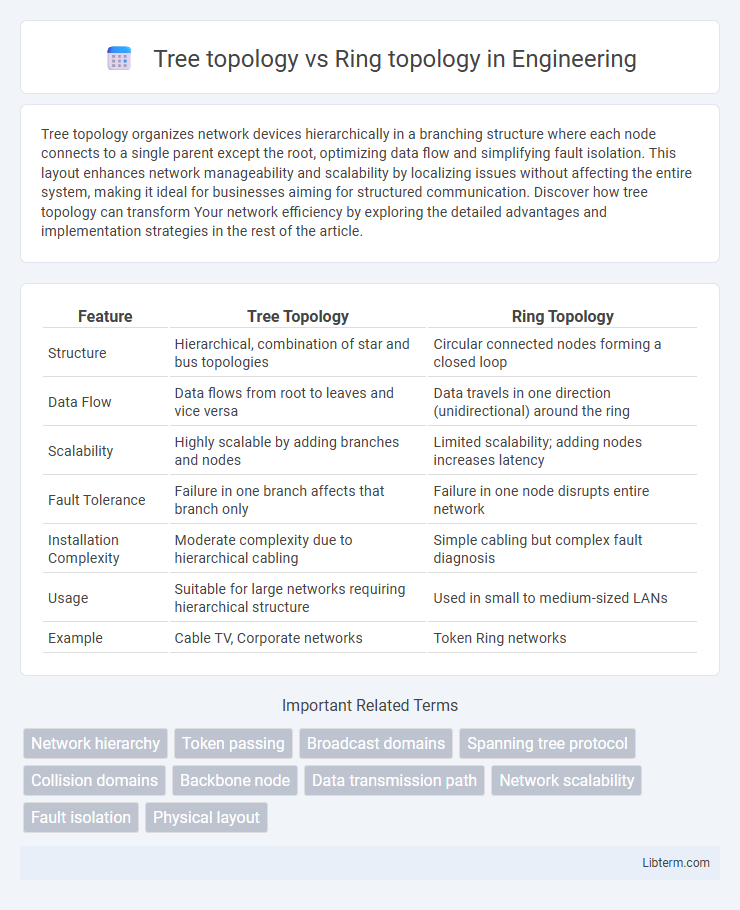Tree topology organizes network devices hierarchically in a branching structure where each node connects to a single parent except the root, optimizing data flow and simplifying fault isolation. This layout enhances network manageability and scalability by localizing issues without affecting the entire system, making it ideal for businesses aiming for structured communication. Discover how tree topology can transform Your network efficiency by exploring the detailed advantages and implementation strategies in the rest of the article.
Table of Comparison
| Feature | Tree Topology | Ring Topology |
|---|---|---|
| Structure | Hierarchical, combination of star and bus topologies | Circular connected nodes forming a closed loop |
| Data Flow | Data flows from root to leaves and vice versa | Data travels in one direction (unidirectional) around the ring |
| Scalability | Highly scalable by adding branches and nodes | Limited scalability; adding nodes increases latency |
| Fault Tolerance | Failure in one branch affects that branch only | Failure in one node disrupts entire network |
| Installation Complexity | Moderate complexity due to hierarchical cabling | Simple cabling but complex fault diagnosis |
| Usage | Suitable for large networks requiring hierarchical structure | Used in small to medium-sized LANs |
| Example | Cable TV, Corporate networks | Token Ring networks |
Introduction to Network Topologies
Tree topology organizes network devices in a hierarchical structure resembling a tree, combining characteristics of star and bus topologies to enhance scalability and manageability. Ring topology connects each device to exactly two other devices, forming a circular data path that enables efficient token passing and reduces collision risks. Both topologies support different use cases; tree topology excels in large, structured networks, while ring topology offers predictable performance in smaller or specialized environments.
Overview of Tree Topology
Tree topology organizes network devices hierarchically, connecting multiple star-configured networks through a central root node, which improves scalability and fault isolation. It supports easy expansion by adding branches without disrupting the entire system, making it ideal for large networks like corporate intranets. Compared to ring topology, tree topology offers better management of data flow and simplifies troubleshooting due to its structured, layered arrangement.
Overview of Ring Topology
Ring topology is a network configuration where each device connects to exactly two other devices, forming a circular data path. Data travels in one or both directions around the ring until it reaches its destination, ensuring orderly network communication. This topology minimizes data collisions and simplifies troubleshooting but can be vulnerable to a single point of failure if redundancy is not implemented.
Structural Differences: Tree vs Ring
Tree topology features a hierarchical structure with multiple levels, where nodes branch out from a single root, enabling efficient data management and fault isolation. Ring topology arranges nodes in a closed loop, with each device connected to exactly two neighbors, ensuring data travels in one or both directions along the ring. The primary structural difference lies in Tree's branched framework compared to Ring's circular configuration, impacting scalability and fault tolerance.
Data Transmission: How Tree and Ring Topologies Work
Tree topology transmits data by hierarchical paths where signals travel from the root node down through branches, enabling efficient routing and easy fault isolation but potentially causing delays if upper nodes fail. Ring topology circulates data in a unidirectional or bidirectional loop using token passing or similar protocols, ensuring equal access for all nodes but making the entire network vulnerable to single-node failures unless dual rings or fault-tolerant mechanisms are implemented. Data transmission in tree topology benefits from structured control and scalability, whereas ring topology maintains consistent timing and orderly data flow.
Scalability and Expansion Considerations
Tree topology offers superior scalability due to its hierarchical structure, allowing easy addition of nodes by branching out from parent nodes without disrupting the entire network. Ring topology faces limitations in expansion since each new device must be added to the ring sequentially, increasing latency and the risk of network failure. Tree topology's segmented design supports larger networks with efficient fault isolation, while ring topology's linear connection can cause bottlenecks as the network grows.
Fault Tolerance and Reliability
Tree topology offers higher fault tolerance and reliability by allowing isolation of network segments; a single node or connection failure affects only a specific branch, maintaining overall network functionality. In contrast, ring topology is more vulnerable, as a break in any single connection can disrupt the entire network unless dual rings or bypass mechanisms are implemented. Network designs prioritize tree topology for environments requiring robust fault isolation and minimal downtime.
Cost and Implementation Complexity
Tree topology generally incurs higher initial costs due to extensive cabling and network devices required to support hierarchical connections, while ring topology tends to be more cost-efficient with fewer cables and simpler node connections. Implementation complexity in tree topology is significant because it involves multiple levels of nodes and requires careful planning to prevent bottlenecks and ensure scalability, whereas ring topology offers easier setup and straightforward maintenance but can face challenges in fault tolerance. Cost-effectiveness of ring topology often suits smaller networks, while tree topology supports complex, larger-scale networks despite higher expenses and complexity.
Use Cases: When to Choose Tree or Ring Topology
Tree topology suits large networks requiring hierarchical structure, such as corporate networks and educational institutions, where scalability and easy fault isolation are crucial. Ring topology is ideal for smaller, localized networks like office buildings or ring-based metropolitan networks, offering consistent data transmission and reduced collision. Choose tree topology for complex systems needing robust management, and ring topology when predictable data flow and fault tolerance in a circular path are priorities.
Conclusion: Comparing Tree and Ring Topologies
Tree topology offers hierarchical organization and scalability, making it ideal for large networks requiring efficient data management. Ring topology provides equal access and simple data transmission but is less scalable and vulnerable to single points of failure. Choosing between them depends on network size, fault tolerance needs, and performance requirements.
Tree topology Infographic

 libterm.com
libterm.com